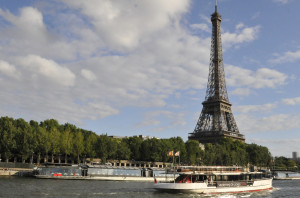In 1887, 300 French writers and artists signed a petition demanding that erection “of this useless and monstrous Eiffel Tower” be halted immediately. What the petitioners called “a giddy, ridiculous tower dominating Paris like a gigantic black smokestack” has become a beloved symbol of Paris, each year attracting almost seven million visitors, more than any other paid monument in the world.
The Eiffel Tower is named for Gustave Eiffel, a French engineer who gained fame in 1880 for his innovative design for an iron truss skeleton for the Statue of Liberty, replacing the planned masonry core. Maurice Koechlin, a member of Eiffel’s firm who worked on that design, learned of a need for an entrance arch near the left bank of the Seine for a world’s fair commemorating the 100th anniversary of the French Revolution. He and colleague Émile Nouguiera proposed an iron lattice arch extending into a tower 300 meters high, far taller than any man-made structure. Initially lukewarm, Eiffel eventually championed the idea of showing the capabilities of iron for very tall structures. His firm’s design, enhanced by architect Émile Nouguiera, was selected in 1886. When the Eiffel Tower was completed in 1889, it nearly doubled the height of the Washington Monument, built entirely of stone.
As originally approved, the Eiffel Tower was to be disassembled after 20 years and its 7,300 tons of iron and 2.5 million rivets sold as scrap. But Gustave Eiffel had other ideas. Soon after the tower’s opening, he began inviting scientists to use it for experiments requiring great heights. In 1919, as the permit was to expire, antennae atop the tower began sending radio signals throughout France and the Eiffel Tower earned a permanent place in the Parisian skyline.
The Eiffel Tower remained the world’s tallest man-made structure until the Chrysler Building surpassed it in 1930, incorporating a steel skeleton pioneered by William Le Baron Jenney, an engineering classmate of Gustave Eiffel in Paris. Today, thanks to Eiffel and his classmate, no one would think of building a tall structure without the “hateful column of bolted sheet metal” disparaged by Eiffel’s nineteenth century critics.
